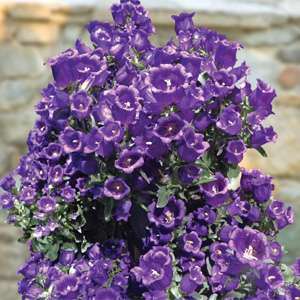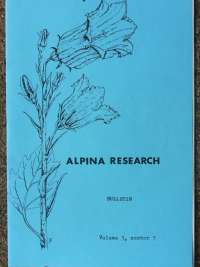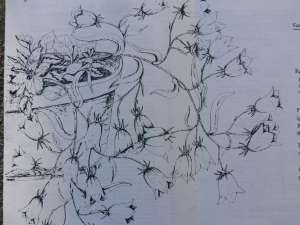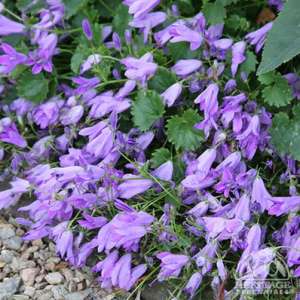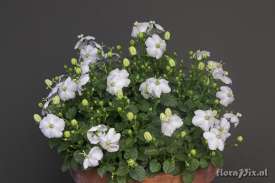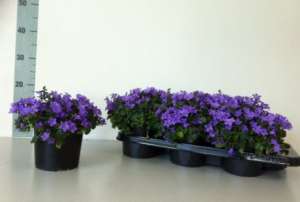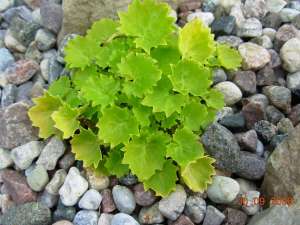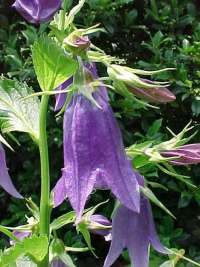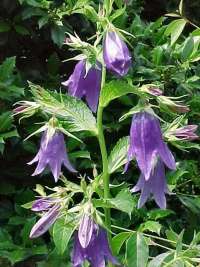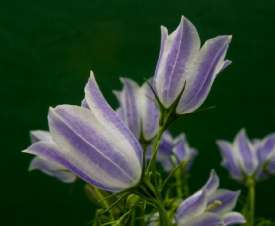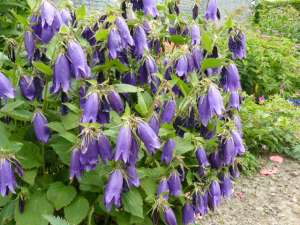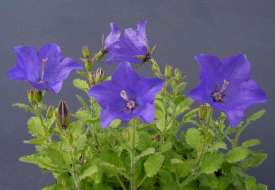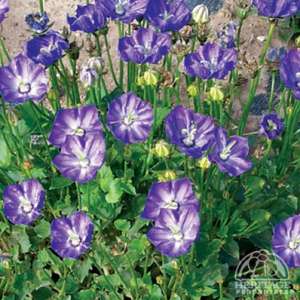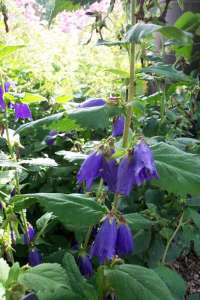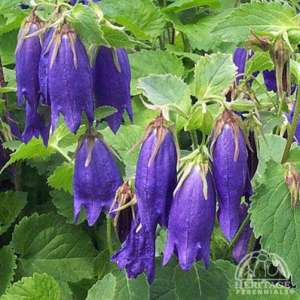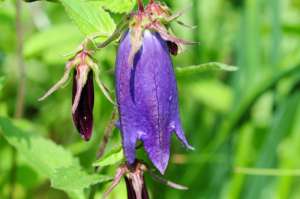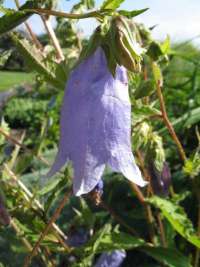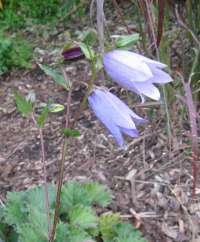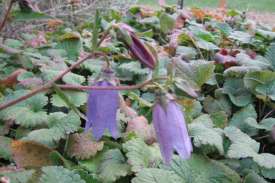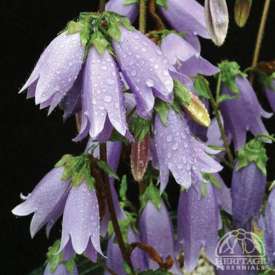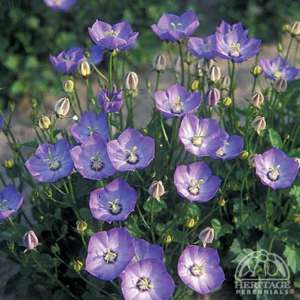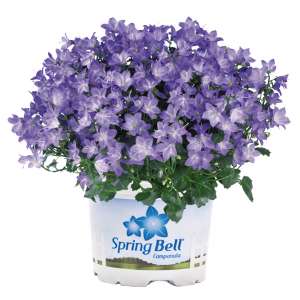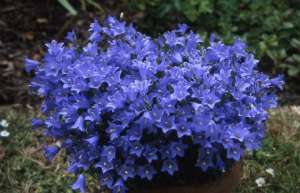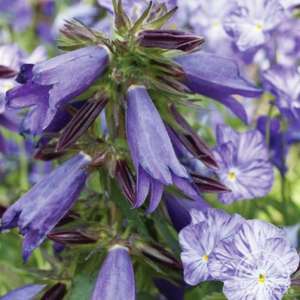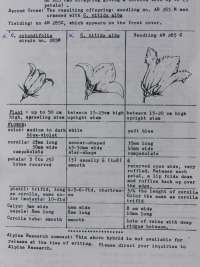Inhoud
hybrida
Also hybrid, hybride
Campanula hybrida
Linn.
Nomenclatuur
synonym Legousia hybrida 1).
Habitus
Caule basi ramoso, stricto; Ann.2)
.Leaves
Foliis oblongis, crenatis: calycibus aggregatis.3)
.Flowers
Corolla longioribus.Flor. Jul. et Aug.4)
.Fruit
Capsula prismatica.5)
.Living
Hab. inter egetes, circa Olisiponem, Conimbricam et alibi.6)
.Varieties
* Campanula hybrid ‘Appeal Deep Blue’ p.p.
Deep bluish-purple, bellshaped flowers with fluted rims adorn the plant for about 6 weeks during the spring and summer season. The short upright plants start to flower on the ends of the stems until the entire stem is filled to capacity with deep purple bellflowers. This eye-catching, patio or indoor plant is intended to be grown as an annual, but it will reward you with sumptuous color and beauty during the blooming season. Hardy to Zone 10 and higher for outdoors. Full or partial sun, grows to 1' in container, minimum temperature 45°, blooms in spring and summer. Easy grower! - See more at: http://www.logees.com/Campanula-Appeal-Deep-Blue-pp/productinfo/R2818-4/#sthash.f2V5YWkX.dpuf * Campanula hybride var. AR 285 C Although this hybrid, cross made at Alpina Research, is still under investigation, observed and propagated more for reliability, we are releasing preliminay results. The cross is numbered AR 285 C. The parents are: * First Cross: Campanula rotundifolia forma heterodoxa x seedling mutant no. 285 (an offspring giving a corolla with up to 25patals). * Second Cross: The resulting offspring;: seedling no. AR 285 M was crossed with Campanula nitida alba. * Yielding: no. AR 285 C, which appears on the front cover.7)
* Campanula hybride var. AR 327 A
Parents: x Elisabeth Frost (strain) by Campanula cochlearifolia (strain).Features: Quantity of blooms of parents. More rampant than x Elisabeth Frost. Ideal for hanging basket. Vigorous. Plenty of propagation material. Flower color: rich purple. Long flowering season.
Note: This hybrid is not for immediate release. Further testing is being done at Alpina Research and other places. 8)
* Campanula hybride var. basket
* Campanula hybride ‘Birch Hybrid’
This dwarf selection is a terrific choice for rock gardens, edging, and particularly for tubs or mixed containers. Plants form a trailing mound of small green leaves, bearing sprays of bright purple bell flowers for many weeks in early summer. Divide every two years, in spring or fall. Consider contrasting ‘Birch Hybrid’ with Coreopsis ‘Moonbeam’ or growing as a carpet beneath Lilies. Removing spent flowers will greatly increase the flowering time. This trailing selection will not become a troublesome spreader. Optimal Growing Conditions: Appearance and Characteristics. Sun Exposure ;Full Sun or Partial Shade. Soil Type; Normal or Sandy or Clay. Soil pH; Neutral or Alkaline or Acid. Soil Moisture; Average or Dry or Moist. Care Level; Easy. Flower Colour; Purple. Blooming Time; Early Summer, Mid Summer, Late Summer, Early Fall. Foliage Color; Deep Green. Plant Uses & Characteristics. Accent: Good Texture/Form, Alpine & Rock, Border, Containers, Edging, Rabbit Resistant, Ground Cover, Massed. Flower Head Size; Medium. Height; 10-15 cm, 4-6 inches. Spread; 20-30 cm, 8-12 inches. Foot Traffic; Light. Growth Rate; Medium. 9)
* Campanula hybride cv. 'Blue Orb'™
Dwarf Hybrid Bellflower USDA Zone: 3-9. Plant number: 1.110.010. This form of Bellflower has a compact habit, making it ideal for rock gardens, edging, or growing in containers. Plants form a low, globe-shaped mound of deep green foliage, bearing azure blue flowers in early summer. Blooms are open, cup-shaped and upfacing for a good display. Remove faded flowers to encourage repeat blooming. A well-behaved plant, not aggressive like some other Bellflowers. USPPP: unlicensed propagation prohibited. Optimal Growing Conditions; Sun Exposure; Full Sun or Partial Shade. Soil Type; Normal or Sandy or Clay. Soil pH; Neutral or Alkaline or Acid. Soil Moisture; Average or Moist Care Level Easy. Flower Colour; Deep Blue. Blooming Time; Early Summer, Mid Summer. Foliage Color; Deep Green. Plant Uses & Characteristics; Accent: Good Texture/Form. Alpine & Rock, Border, Containers, Edging, Rabbit Resistant; Massed. Flower Head Size; Small. Height; 15-20 cm, 6-8 inches. Spread; 20-30 cm, 8-12 inches. Foot Traffic; None. Growth Rate; Medium.10)
* Campanula hybride cv. 'Blythe Spirit'
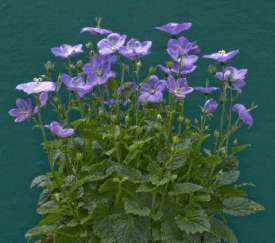
* Campanula hybride var. birch hybrid
* Campanula hybride cv. 'Catharina Blue'
Potplant, for the garden - Breeder: Van Winden Erica BV - The Netherlands.
* Campanula hybride var. 'Dicksons Gold'
* Campanula hybride var. karpaten kronen
* Campanula hybride cv. 'Kent Belle'
The new cultivar ‘Purple Sensation’ is most similar in plant habit and flower form to the cultivar Campanula ‘Kent Belle’ (unpatented), a hybrid between Campanula takesimana and Campanula latifolia and ‘Kent Belle’ is presumed to be of similar origin. ‘Purple Sensation’ differs from ‘Kent Belle’ in having darker green foliage, darker purple flowers and a shorter plant height. Ref.:Google - Patents. 'Kent Belle' is an upright, clump-forming perennial which typically grows 18-28“ tall. Large, drooping, tubular, glossy violet, bell-like flowers (to 2” long) with inside spotting appear in terminal racemes atop erect to slightly arching stems. Stems rise up from basal rosettes of rounded, toothed, medium green leaves (to 5“ long). Long late spring to early summer bloom. Light rebloom may occur in autumn. Borders, rock gardens, cottage gardens, lightly shaded woodland settings or naturalized areas. Group or mass for best effect. Easily grown in average, medium, well-drained soil in full sun to part shade. Prefers part shade in hot summer climates. Does not do well when night temperatures do not consistently cool down below 70 degrees F. Needs regular moisture. Plants may be cut back to basal foliage after bloom. Divide clumps in fall every 3-4 years. Spreads freely by rhizomes under optimum growing conditions. This cultivar is sterile and accordingly will not self-seed.11) Hybrid Bellflower - USDA Zone: 4-9, Plant number: 1.110.750. This tall selection is perfect for the sun or part-shade border. Plants form a mound of dark green leaves, bearing upright stems with huge drooping bells in a rich deep-purple shade. Plan to give this space. Easily divided in spring or fall. Stems will need to be staked. Combines beautifully with Cranesbill Geraniums, Phlox or Hosta. Also excellent in containers or tubs. Removing spent flowers will increase blooming time. Outstanding cut flower. Optimal Growing Conditions, Appearance and Characteristics. Sun Exposure; Full Sun or Partial Shade. Soil Type; Normal or Sandy or Clay. Soil pH; Neutral or Alkaline or Acid. Soil Moisture; Average or Moist. Care Level; Easy. Flower Colour; Purple. Blooming Time; Early Summer, Mid Summer, Late Summer. Foliage Color; Deep Green. Plant Uses & Characteristics; Accent: Good. Texture/Form; Border, Containers, Cut Flower, Rabbit Resistant, Massed Specimen. Flower Head Size; Very Large. Height; 70-120 cm, 27-47 inches. Spread; 45-60 cm, 18-23 inches. Foot Traffic; None. Growth Rate; Medium.12)
* Campanula hybride cv. 'Margeret Brine'
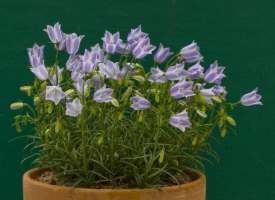
* Campanula hybride cv. 'Maie Blyth'
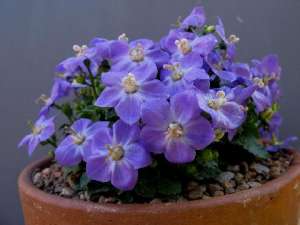
* Campanula hybride cv. 'Molly Pinsent'

* Campanula hybride cv. 'Purple Sensation' (PBR) -
This particular variety is an interspecific hybrid. A new cultivar of hybrid Campanula, ‘Purple Sensation’, characterized by deep purple colored flowers, dark green foliage and purple stems. ‘Purple Sensation’ is hardy to USDA Zone 3 and is shorter in height than is typical for this type of Campanula. The inventor discovered the new cultivar, ‘Purple Sensation’, in a cultivated growing area at his nursery in Noordwijkerhout, The Netherlands in the summer of 2000. ‘Purple Sensation’ originated as a chance seedling and the parentage is unknown. The new cultivar is most similar in plant habit and flower form to the cultivar Campanula ‘Kent Belle’ (unpatented), a hybrid between Campanula takesimana and Campanula latifolia and ‘Kent Belle’ is presumed to be of similar origin. ‘Purple Sensation’ differs from ‘Kent Belle’ in having darker green foliage, darker purple flowers and a shorter plant height.Ref.:Google - Patents. Large, dark purple bells hang in profusion on a compact plant. Great for front of border or containers. Type Hardy perennial. Height 30cm to 60cm. Flowering Mid Summer. Best in full sun, or part shade. Feature: Huge purple bells emerge from black buds.13)
* Campanula hybride cv. Rick Lupp

* Campanula hybride var. riverslea
* Campanula hybride cv. ‘Royal Wave’
Dwarf Hybrid Bellflower USDA Zone: 5-9. Plant number: 1.110.930. This recently introduced hybrid Bellflower is a terrific compact selection for planting near the border edge, using in mixed containers or in the rock garden. The small green leaves form a low mound, bearing a long succession of large, upfacing cup-shaped blooms. Flowers are violet-blue with a white center, and amazingly fragrant. Because this variety is sterile, flowering continues for many weeks with no deadheading required. Foliage is sturdy and quite heat resistant. USPP#17761: unlicensed propagation prohibited. Registered with COPF. Optimal Growing Conditions Appearance and Characteristics. Sun Exposure; Full Sun or Partial Shade. Soil Type; Normal or Sandy or Clay. Soil pH; Neutral or Alkaline or Acid. Soil Moisture; Average or Moist. Care Level; Easy. Flower Colour; Purple. Blooming Time; Early Summer, Mid Summer, Late Summer, Late Spring. Foliage Color; Deep Green. Plant Uses & Characteristics. Accent: Good Texture/Form, Alpine & Rock, Border, Containers, Edging, Rabbit Resistant, Massed. Flower Head Size; Medium. Height; 15-25 cm, 6-10 inches. Spread; 30-40 cm, 12-16 inches. Foot Traffic; None. Growth Rate; Medium.14)
* Campanula hybride cv. 'Sarastro'
A clumping, hybrid bellflower (reportedly Campanula punctata x Campanula trachelium) noted for producing deep blue bell-shaped flowers on slowly-spreading, compact plants that typically rise to 20-26” tall and as wide. Large, shiny, tubular flowers (to 2.5” long) are deep blue to purple blue. Flowers droop from leafy stems over a long mid to late summer bloom. Stems rise up from basal rosettes of medium green leaves. Campanula comes from Latin and means little bell. Borders, rock gardens, cottage gardens, lightly shaded woodland settings or naturalized areas. Group or mass for best effect. Effective ground cover. Strong stems make this a good container plant. Easily grown in average, medium moisture, well-drained soils in full sun to part shade. Prefers some part shade in hot summer climates. Plants need regular moisture. Deadhead spent flowers to encourage additional bloom. Divide clumps in fall every 3-4 years. Plants may spread by rhizomes under optimum growing conditions, but not as aggressively as is the case with Campanula punctata. 15)
The flower color is violet blue and the flowering period is from about June to August. The leaves are green and about 25 cm. high. The mature height of this perennial is 50 cm. Withstands temperatures up to -30 gr. C. This plant is very suitable for fairly open gardens with a single mature tree or shrub. Requires a slightly shaded spot near trees and shrubs. The soil should be nutrient rich and moist to moist. It is an invasive plant with many root suckers.16) Hybrid Bellflower - USDA Zone: 4-9. Plant number: 1.110.920. This selection is similar to ‘Kent Belle’ but with a more bushy, compact habit and an even longer blooming season. Plants form a mound of dark green leaves, bearing upright stems with huge drooping bells in a rich deep violet-purple shade. Easily divided in spring or fall. Stems will need to be staked. Combines beautifully with Cranesbill Geraniums, Phlox or Hosta. Also excellent in containers or tubs. Removing spent flowers will increase blooming time. Outstanding cut flower. Optimal Growing Conditions Appearance and Characteristics. Sun Exposure; Full Sun or Partial Shade. Soil Type; Normal or Sandy or Clay. Soil pH; Neutral or Alkaline or Acid. Soil Moisture; Average or Moist. Care Level; Easy. Flower Colour; Purple. Blooming Time; Early Summer, Mid Summer, Late Summer. Foliage Color; Deep Green. Plant Uses & Characteristics; Accent: Good Texture/Form, Border, Containers, Cut Flower, Rabbit Resistant, Massed, Specimen. Flower Head Size; Large. Height; 45-60 cm, 18-23 inches. Spread ; 45-60 cm, 18-23 inches. Foot Traffic; None. Growth Rate; Medium.17)
* Campanula hybride cv. 'Summertime Blues'
A clump-forming bellflower cultivar that is noted for its extremely long late spring to late summer (sometimes into fall) bloom of large, tubular, drooping, bell-like, silvery blue flowers on leafy, upright, burgundy stems rising to 24” tall. U. S. Plant Patent Applied For (PPAF). Borders, rock gardens, cottage gardens or lightly shaded woodland settings. Group or mass for best effect. Easily grown in average, medium moisture, well-drained soils in full sun to part shade. Plants prefer some part afternoon shade in hot summer climates. Sharp soil drainage with consistent moisture is important. This hybrid is much tamer than some other campanulas in that it does not produce seed and does not spread by rhizomes in the garden.18)
Hybrid Bellflower - USDA Zone: 0-0, Plant number: 1.110.020. This tall selection is perfect for the sun or partially shaded border. Plants form a mound of dark green leaves, bearing upright stems with huge drooping bells in a silver-blue shade. Plan to give this space. Easily divided in spring or fall. Combines beautifully with Cranesbill Geraniums, Phlox or Hosta. Also excellent in containers and tubs. Removing spent flowers will increase blooming time. Outstanding cut flower. USPP#19261: unlicensed propagation prohibited. Registered with COPF. Optimal Growing Conditions Appearance and Characteristics. Sun Exposure; Full Sun or Partial Shade. Soil Type; Normal or Sandy or Clay. Soil pH; Neutral or Alkaline or Acid. Soil Moisture; Average or Moist. Care Level; Easy. Flower Colour; Deep Blue. Blooming Time; Early Summer, Mid Summer, Late Summer. Foliage Color; Deep Green. Plant Uses & Characteristics. Accent: Good Texture/Form, Border, Containers, Cut Flower, Rabbit Resistant, Massed Specimen. Flower Head Size; Very Large. Height; 50-60 cm, 20-23 inches. Spread; 40-45 cm, 16-18 inches. Foot Traffic; None. Growth Rate; Medium.19)* Campanula hybride cv. ‘Samantha’
Dwarf Hybrid Bellflower USDA Zone: 5-9. Plant number: 1.110.910. This form of Bellflower has a compact habit, making it ideal for rock gardens, edging, or growing in containers. Plants form a low mat of deep green foliage, bearing short sprays of fragrant mauve-blue flowers in early summer. Blooms are open, cup-shaped and upfacing for a good display. Remove faded flowers to encourage repeat blooming. A well-behaved plant, not aggressive like some other Bellflowers. Optimal Growing Conditions Appearance and Characteristics. Sun Exposure; Full Sun or Partial Shade. Soil Type; Normal or Sandy or Clay. Soil pH; Neutral or Alkaline or Acid. Soil Moisture; Average or Moist. Care Level; Easy. Flower Colour; Mauve/Lilac. Blooming Time; Early Summer, Mid Summer. Foliage Color; Deep Green. Plant Uses & Characteristics; Accent: Good Texture/Form, Alpine & Rock, Border, Containers, Edging, Rabbit Resistant, Fragrant, Massed. Flower Head Size; Small. Height; 10-15 cm, 4-6 inches. Spread; 25-40 cm, 10-16 inches. Foot Traffic; None. Growth Rate; Medium.20) * Campanula 'Spring Bell Blue'®
Campanula 'Spring Bell® Blue' was created by crossing various Campanula species. The goal of the breeding programme was to create the perfect deep blue Campanula. Several years’ work by some of the best breeders in the world led to this new deep blue Campanula variety. By crossing Campanula species the best of their qualities have come together in 'Spring Bell'®. After 'Spring Bell® Blue', in 2013 a white one - 'Spring Bell® White' - is also to be introduced.
Campanula 'Spring Bell® Blue' bright blue flowers, dark green foliage. Because of its sterile flowers don’t set seed, 'Spring Bell'® keeps flowering abundantly over a long period and can be kept both indoors and outdoors. Once the plant has finished flowering indoors, it can be planted in a sunny or partly shaded spot in the garden. The natural flowering period is June, but it can produce a second flush of flowers in September. It is winter-hardy and will surprise you again the following year with its splendid display of flowers!
* Campanula hybride cv. 'Timsbury Perfection'
* Campanula hybride cv. ‘Viking’
Hybrid Bellflower - USDA Zone: 5-9. Plant number: 1.111.150. This Dutch selection has a well-behaved, non spreading habit. It forms a low mound of green leaves bearing upright spikes of large, dangling lavender-mauve bells in early summer. An outstanding cut flower and a favourite of hummingbirds. Quite possibly hardy to Zone 4 or colder. Bred by Arie Blom at AB-Cultivars. USPP#21021, CPBRAF: unlicensed propagation prohibited. Registered with COPF. Optimal Growing Conditions Appearance and Characteristics. Sun Exposure; Full Sun or Partial Shade. Soil Type; Normal or Sandy or Clay. Soil pH; Neutral or Alkaline or Acid. Soil Moisture; Average or Moist. Care Level; Easy. Flower Colour; Light Blue, Mauve/Lilac. Blooming Time; Early Summer, Mid Summer, Late Spring. Foliage Color; Deep Green. Plant Uses & Characteristics. Accent: Good, Texture/Form, Border, Containers, Cut Flower, Rabbit Resistant, Massed, Flower Head Size; Medium. Height; 40-45 cm, 16-18 inches. Spread; 45-60 cm, 18-23 inches. Foot Traffic; None. Growth Rate; Medium.21)
Breeding
* Campanula 'Blythe Spirit' - Locality: New Zealand - Dunedin - Photographer: Graham Nicholls - Note: This white flowered cultivar was raisd by Lesley Cox of Gala Plants, Dunedin from seed collected from Campanula 'Maie Blyth'. Propagation is from cuttings in spring. * Campanula 'Rick Lupp' - Locality: England - Timsbury - Photographer: Graham Nicholls - Note: This is a plant raised from seed collected form Campanula raineri in my alpine house. It is difficult to work out which plant it crossed with. The flowers are of a deep blue and formed as Campanula raineri but the growth is more vigorous. I named it 'Rick Lupp' after my very good friend who is proprietor of Mt. Tahoma Nursery in Graham, Washington State, USA. * Campanula 'Timsbury Perfection' - Photographer: Graham Nicholls - Note: A plant raised by myself from seed of the dwarf Campanula rotundifolia ssp. arctica 'Mt. Jotunheimen several years ago. It is perfection in blooming as well as growing well in the garden. It was given a PC in 2001. * Campanula ? sp 'Margaret Brine' - Locality: Europe - Photographer: Graham Nicholls -Note: This campanula was given to me in February 2011 as a small potted up piece from a garden and described as being a beautiful colour break. Having now grown it to flowering size I fully agree. Although it has the cultivar name 'Margaret Brine' I am trying to identify the species which at first sight to me seems to be Campanula pulla but all suggestions are welcome. Hopefully we will get a better ID soon. It will make a lovely show plant. Identification: asked.


